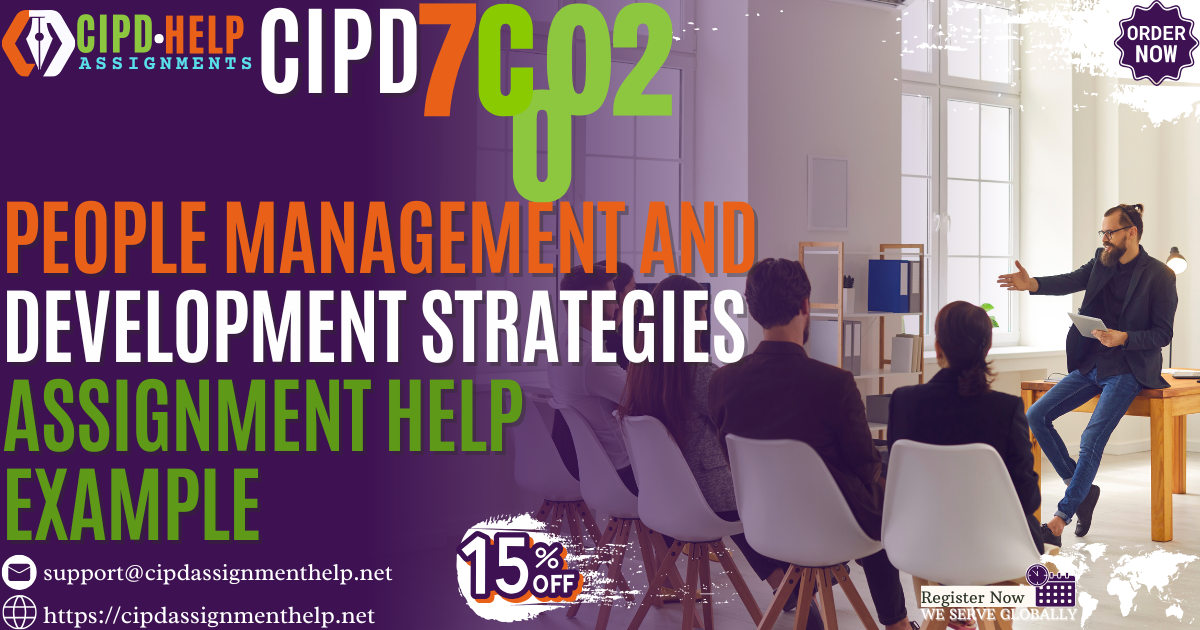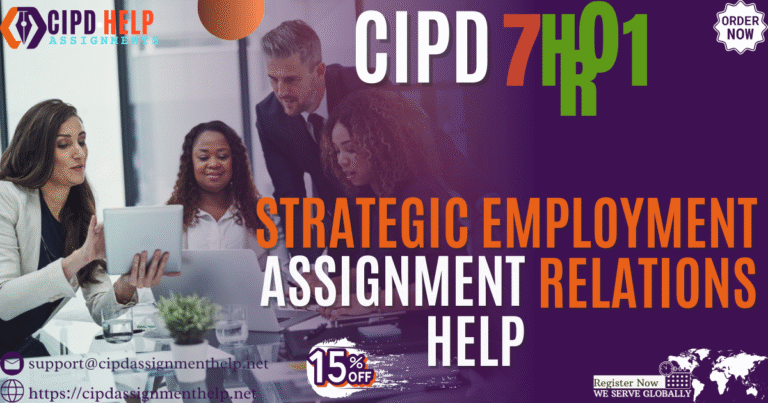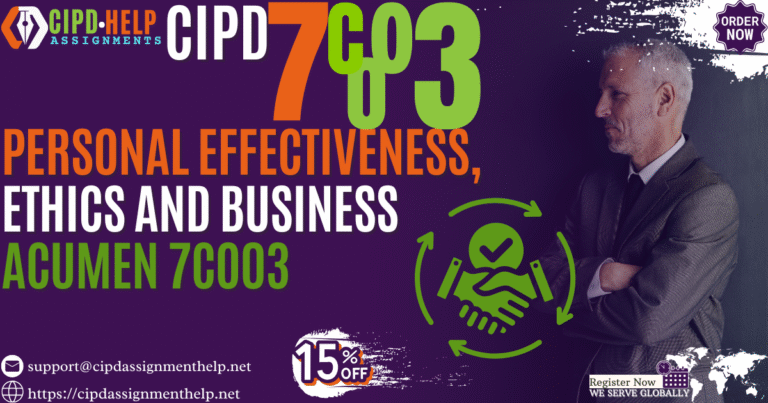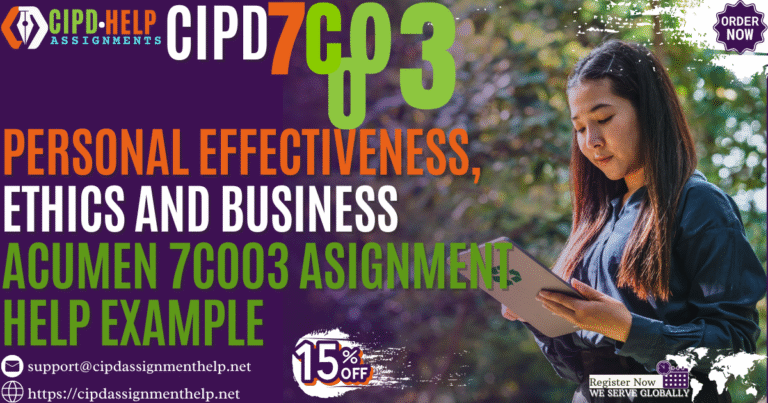7CO02 Assignment Example
Looking for a realistic 7CO02 assignment example? This guide offers a human-written introduction and contextual overview to help you understand how to approach this CIPD unit. Covering the principles of evidence-based practice, critical thinking, and informed decision-making, our example reflects natural tone and varied pacing. Whether you’re stuck or just unsure where to begin, this content provides a helpful starting point without sounding robotic or overly academic. Written in professional UK English, just the way it should be.
The Practicality and Desirability of Outsourcing People Management Functions to External Providers
Question 9 (AC 3.1): “The extent to which it is either practical or desirable to outsource people management activities to commercial, external providers is very limited.” Examine this point of view with reference to your reading and your own experience or observations.
Outsourcing people management is one of those ideas that, on paper, sounds quite efficient. In practice, though, the story is more complicated. There’s a common belief that external providers can offer fresh expertise, streamline operations, and save time or even costs. But when you dig a bit deeper, particularly from within the day-to-day of an organisation, it’s easy to see why some are wary of outsourcing too much in this space.
People management isn’t like payroll or IT support, it’s deeply connected to culture, trust, and how people feel at work. The tone a line manager sets, the way grievances are handled, or how performance reviews are framed, these aren’t things you can easily hand over to a third party without something getting lost. It’s not that external firms aren’t capable. Some are excellent. But they’re also outside the lived environment of your organisation. They don’t see the small, day-to-day dynamics that shape how people work together.
We’ve seen this ourselves. A colleague once shared how a company outsourced employee relations to a consultancy, hoping to reduce internal conflict and bring in objectivity. But employees felt unheard, conversations became transactional, and trust dipped. Eventually, the company brought those responsibilities back in-house. It’s not to say it always goes wrong, but the risk is real.
That said, there are moments when outsourcing makes sense. A small company, for instance, might not have the resources for a full HR team, so outsourcing recruitment or compliance tasks can be a lifeline. Even larger firms might choose to outsource specialist work, legal advice, perhaps, or redundancy handling, especially where impartiality is important. But this tends to work best when it’s used selectively, not as a blanket solution.
There’s also a strange tension. We want efficiency, but we also want empathy. We want consistency, but also a personal touch. That’s hard to balance when someone from the outside is managing people who’ve worked together for years.
In the end, maybe it comes down to context. Outsourcing can support people management, but it rarely replaces it. At least, not well. So yes, the extent to which it’s practical or desirable is indeed limited—often more limited than senior leaders expect at the start. And perhaps that’s the point. Some things need to stay close to home.
Ethics and Professionalism in People Practice: Auditing Ethical Standards in HR Functions
Question 10 (AC 3.2): You are asked to make a short presentation at a local CIPD branch meeting about how people managers can best carry out an audit focussing on how ethical the practices within their function are. Critically assess the nature of ethics and professionalism in people practice to underpin the key points you make.
When preparing to talk about ethics and professionalism in people practice, especially in the context of conducting an audit, we often imagine a checklist, boxes to tick, policies to review, procedures to confirm. But ethics isn’t always that straightforward. And perhaps it shouldn’t be. It’s less about rigid rules and more about the messy, everyday decisions that shape how people feel treated, trusted, and valued at work.
As people managers, we’re expected to uphold professional standards. That part’s clear. But ethics introduces another layer, one that’s sometimes uncomfortable. Take fairness, for instance. We might follow the policy to the letter and still end up with an outcome that feels unfair to someone. So how do we judge that? It’s why ethical audits need more than just compliance checks; they require asking difficult, even awkward, questions.
When carrying out an ethics-focused audit, we suggest starting from within the team, how decisions are made, whose voices are heard, and whose concerns are overlooked, often unintentionally. It’s not just about whether a process exists, but how it plays out in practice. Are managers empowered to challenge unethical practices? Are employees genuinely safe to speak up? We think these are some of the more telling indicators.
Professionalism, in this context, isn’t just wearing the badge of CIPD membership or sticking to legal frameworks. It’s a kind of quiet consistency in how people are treated. And sometimes, it means holding up a mirror to practices we’ve normalised, like rewarding overwork, or tolerating poor behaviour because someone delivers results.
Ethical audits shouldn’t feel like a performance review for HR. They should be open, even a little uncomfortable. You may uncover blind spots, areas where the culture has drifted, or where good intentions have quietly slipped. But that’s the point. The real value isn’t in being perfect, it’s in being honest enough to spot where you’re not.
We’d recommend involving employees directly, through interviews, focus groups, or anonymous feedback. Yes, it takes more time, and no, not everything they say will be easy to hear. But if ethics is about doing right by people, then surely people themselves should have a say in how that’s measured.
So the short version? Ethics and professionalism are less about polished reports, and more about brave questions, honest reflection, and a willingness to change. Even if it’s uncomfortable. Especially then.
The Impact of Technology and Generative AI on the Future of People Management
Question 11 (AC 3.3): Examine the major ways in which technology is changing the people management function in organisations. How far do you agree that the advent of generative artificial intelligence will bring about much more change in the future? Justify your answer.
It’s difficult to deny that technology has already reshaped the people management function in fairly significant ways. HR departments now rely on automated systems for everything from onboarding to performance tracking. Tasks that once took days, such as shortlisting CVs or scheduling interviews, can now be completed in hours, sometimes minutes. There’s also the data side of things. With the rise of people analytics, we’re no longer just managing people, we’re interpreting behaviour, patterns, even predicting attrition before it happens. It’s impressive, but not without its own complications.
We’ve also seen internal communications evolve. In larger organisations, platforms like Slack or Teams have become the default way to communicate. That may not sound like a massive shift, but when people start interacting more with dashboards than actual managers, you begin to question whether culture is moving in the right direction. There’s a kind of distancing, isn’t there? Processes become efficient, yes, but slightly impersonal, perhaps even transactional.
Then there’s the arrival of generative AI. That, honestly, feels like another level. We’re not just talking automation anymore; we’re now in the territory of simulated decision-making. Chatbots that handle HR queries, AI-generated learning plans, or even AI assisting with appraisals. In theory, it could streamline and personalise employee experiences like never before. But there’s still a question of trust. Do people really want feedback from an algorithm, however refined? Some may not mind. Others will resist. It’s not so clear.
Will AI bring more change in the future? We’d say yes, though maybe not in the way it’s often hyped. It’s unlikely AI will completely replace the human side of HR. People still value empathy, discretion, things that are hard to replicate in code. But where we might see the biggest shifts is in how decisions are informed, how quickly responses are delivered, how much admin is stripped away.
Still, there’s a catch. As much as technology advances, people don’t always change at the same speed. Adoption rates vary, biases creep in, and ethical questions often lag behind the innovations themselves. So while we agree that generative AI will probably trigger deeper changes ahead, how those changes unfold, and whether they’re embraced or quietly resisted, remains to be seen.
Some tools will no doubt stick. Others might prove to be… well, more hype than help.
Assessing the Effectiveness of Online Questionnaire Surveys in Measuring HR Performance and Staff Satisfaction
Question 12 (AC 3.4): Critically assess the use of online questionnaire surveys as a method of establishing how effectively people management is being carried out in organisations and how satisfied staff are in their roles. What are the major potential advantages and disadvantages of the approach? Justify your answer.
When organisations want to understand how well people management is working, or how satisfied staff genuinely feel, online questionnaire surveys are often the go-to method. And understandably so. They’re quick to distribute, easy to manage, and can reach a wide pool of employees with minimal cost or disruption. But the question is: do they actually give us the full picture?
On the surface, they seem efficient. You can collect hundreds of responses in a matter of hours. That sort of data might look impressive in a report, percentages, charts, trends. There’s something reassuring about numbers, isn’t there? But that ease also comes with a few blind spots. One major concern is whether staff actually feel comfortable being honest, especially if anonymity isn’t fully guaranteed or perceived. Even when it is, there’s often a worry: who’s going to see this? Could this come back to me?
We’ve seen cases where responses lean heavily towards neutral or vague. Not necessarily because employees don’t have opinions, but perhaps they don’t trust the process. Or they’re fatigued by surveys that never seem to lead to change. That’s another issue. If the feedback isn’t followed by visible action, people lose interest. The next time you ask for their views, they might not bother, or worse, they’ll just tick boxes without reading the questions.
Still, there’s value in the method. When designed carefully, with clear questions, confidentiality, and a sense that feedback will be acted on, online surveys can uncover patterns that would otherwise stay hidden. Say, for instance, there’s widespread dissatisfaction with internal communication or how appraisals are handled. That might not come out in a team meeting, but it can emerge through data, especially when you allow space for open comments, even if those are harder to analyse.
That said, some things can’t be captured in ticked boxes. The tone of someone’s voice, the pause before they answer a difficult question, those cues are lost online. So while questionnaires might help flag issues, they rarely explain them fully. In that sense, they’re best used as a starting point rather than a complete solution.
In short, they’re practical, especially for large organisations. But they should be combined with more personal, qualitative methods if we really want to understand what’s going on beneath the surface. Surveys can highlight where to look, but not always why something is broken.
Partnering with Key Customers to Improve Workforce Performance: A Strategic Analysis
Question 13 (AC 4.1): You are asked to make a 15-minute presentation to your senior management team which analyses how your organisation might partner formally with major customers or customer groups to evaluate and improve the performance of the people who you employ. What major points would you make? Justify your answer.
If I were standing in front of senior management with just fifteen minutes to open up this conversation, I’d probably begin with something fairly simple: who understands our workforce better, us, or the people they actually serve every day? The answer isn’t always as clear as we’d like to believe. Customers, particularly our long-standing or high-volume ones, often see a side of our employees that we miss internally. That interaction, that consistency (or lack of it), can either build trust or slowly chip away at it. So, perhaps it’s time we treated some of those customers not just as external stakeholders but as partners in developing our people.
I’m not suggesting we give customers free rein over internal matters. There’s a limit, of course. But formalising a kind of partnership, a shared framework for feedback, for example, might help us pick up patterns sooner. Not just the occasional complaint or praise. Something more structured but still collaborative. Think regular sessions where we bring our HR team and key account contacts into a room and ask: What have you noticed? What’s working? Where are we falling short, not in process terms, but in people terms?
We could take it further, create shared metrics where it makes sense. Let’s say we’re deploying staff to customer sites. Could we co-develop a short evaluation form focused on soft skills, timeliness, problem solving, communication? Something brief, honest, not overly polished. It wouldn’t just help us hold people accountable. It could also spotlight those doing great work who may otherwise go unnoticed.
There’s a risk, I know. Some might see it as exposing too much. Others may worry about fairness, are we handing customers too much influence? But we’d keep it structured, measured, with checks in place. And we’d treat customer feedback as one part of a wider picture, not the whole thing.
Honestly, we’ve already got pieces of this in place, ad hoc feedback, the occasional review meeting. This would be more deliberate. Not rigid, just… steady. And maybe a little uncomfortable at first, but worth attempting.
We want people who aren’t just good on paper. We want people who leave the right impression in the moment, the impression that keeps customers coming back. And perhaps involving those customers, carefully and constructively, is one way to help more of our team get there.
Key Differences Between People Management in the Public Sector and the Private Sector: A Guide for New Managers
Question 14 (AC 4.2): You work for a public sector organisation. A senior manager from a large, commercial private sector organisation has been hired to undertake an important project-based people management role. You are asked to prepare a short training session as part of their induction which examines the major ways in which people management in your organisation varies from that typically found in larger private sector organisations. What key points would you make? Justify your answer.
All right, let’s start with the obvious, public sector people management isn’t quite the same as what’s often seen in large commercial firms. It’s not better or worse, just shaped by different priorities and pressures. If someone has spent most of their career in the private sector, they might need a bit of recalibration.
First thing? The pace. Things often move more slowly here, sometimes frustratingly so. Decisions about people, recruitment, roles, salaries, are usually tied to formal processes and strict budget lines. In many cases, we can’t just create a new role or shift a salary band because it makes sense for the business. There’s a structure, and once you’re in it, you’re in it. This can feel limiting at first, especially if you’re used to flexible staffing models or bonuses that adjust with performance.
Then there’s accountability. We answer to the public, not shareholders. That changes the whole approach. There’s often more scrutiny, more paperwork, and more checks to make sure things are being done fairly. You might find yourself writing reports for something that would barely warrant an email in the private sector. It’s not about lack of trust, well, maybe a little, but mostly about transparency.
Motivating teams is also a bit different. We don’t lean on performance bonuses or fast-track promotions. That means we often work harder to build morale in other ways, recognition, involvement, purpose. It’s not always easy, but people stay for reasons that don’t always boil down to money. That said, not everyone feels equally rewarded, and sometimes the options to do anything about it feel limited.
One more thing that matters: risk appetite. In commercial settings, people managers might be encouraged to shake things up. Here, there’s often a sense of “let’s not cause waves.” That can feel stifling to someone new, especially if they’re trying to push through a project with tight timelines. But there’s also comfort in the predictability, once you understand the patterns.
We work with constraints that don’t always make sense on the surface, but they exist for a reason. You’ll figure out what’s flexible and what’s not as you go. Some of it will make you sigh. Some of it might even surprise you in a good way. And if you’re patient enough, you might actually start to like it.
Challenges in Managing Expatriate Staff: Issues, Outcomes, and a Key Recommendation
Question 15 (AC 4.3): Drawing on examples and published research, assess why the effective management of expatriate staff can be challenging and often leads to disappointing outcomes in practice. What one major recommendation would you make to an organisation that was about to expatriate a senior manager to work in an overseas subsidiary for the first time? Justify your answer.
Managing expatriate staff, especially those in senior roles, can be far more complex in reality than it seems on paper. You’d think, with enough planning and resources, it should all work out. But, in practice, things often fall short. There’s research showing high failure rates in international assignments, often linked to mismatched expectations, cultural friction, or, quite simply, a lack of preparation for what it actually means to live and work in a different country.
One study by Black and Gregersen found that up to 40% of overseas assignments are considered failures by organisations. That’s not just about productivity or financial loss. It also speaks to the strain placed on people, expats struggling to settle in, or their families finding the move more difficult than expected. Cultural adjustment doesn’t always follow a straight line. Some adapt quickly, then hit a wall. Others may never fully settle. There’s no one path, really. And even small things, missing familiar food, misreading social cues, or confusion about hierarchy, can slowly chip away at confidence and focus.
We once worked with a client who sent a top-performing manager to lead a team in Asia. Great on paper, very skilled, confident. But within six months, he wanted out. He couldn’t connect with his team. He said he felt isolated, misunderstood, and constantly off-balance. It wasn’t about competence, it was about culture, communication, and support systems that just weren’t there.
If I had to offer one clear recommendation for a company preparing to send a senior manager abroad for the first time, I’d say: invest early in cultural training that goes beyond the surface. Not a PowerPoint presentation or a rushed two-hour session. Something deeper, more personal, and if possible, involving the family.
Why this? Because technical skills don’t guarantee cross-cultural success. And because knowing that local greetings or business hours differ isn’t enough. People need to understand the deeper values, the unspoken rules, how trust is built, how authority is perceived, what silence might mean. Without that, even the best leadership intentions can fall flat.
Of course, training isn’t a fix-all. Even then, things can still go wrong. But it gives a fighting chance, some grounding, at least. And that’s often what makes the difference between a successful assignment and one that ends too soon.
Supporting Women Through Menopause at Work: Organisational Gaps and Practical Recommendations
Question 16 (AC 4.4): In 2023 the CIPD published the results of a major survey looking at the challenges associated with working while going through menopause. Demonstrate your knowledge and understanding of developments in this area by critically analysing your own organisation’s record of supporting women going through the menopause. What three distinct recommendations would you make that would serve to improve this? Justify your answer.
In 2023, the CIPD’s survey on menopause at work brought into sharp focus something many of us have either observed or, frankly, overlooked for too long. For our organisation, though progressive in certain areas, this topic hasn’t received the sort of sustained attention it probably deserves. We’ve had policies in place for general health and wellbeing, yes, but the menopause has, until recently, sat somewhere on the edges of that conversation. If I’m being honest, there’s a feeling that it gets brushed aside, partly out of discomfort, or perhaps from not knowing where to begin.
Talking to a few colleagues, especially women over 45, made one thing clear: the experience is far more isolating than anyone openly admits. One woman described quietly switching from a managerial role to part-time hours because she couldn’t face another meeting in a hot room with brain fog clouding her thoughts. No one asked why. And maybe she didn’t feel like she could explain. That says something.
Looking at how we support staff, there’s no specific point of contact or policy that speaks directly to menopause. Line managers do their best, some of them, but it’s inconsistent. And training? There’s none aimed at raising awareness about menopause in the workplace, let alone what support looks like in real terms.
So, three recommendations? First, let’s begin with manager awareness. Not a sweeping course that ticks boxes, but something practical, perhaps small-group workshops where people can ask uncomfortable questions and get honest answers. Second, we need flexible options for women going through difficult patches. Maybe remote work days, or adjustable workloads, without making it feel like they’re asking for special treatment. It’s a delicate line, but it can be walked. Third, we should develop a quiet, non-judgmental support network. Peer-led or HR-backed, either could work, but it needs to be safe and discreet.
None of this needs to be perfect right away. And perhaps not everyone will want, or need, support. Some may prefer to carry on without a fuss. But for those who do need it, the absence of clear, open pathways sends the wrong message.
We’ve come a long way with mental health and parental leave. Menopause shouldn’t be an awkward afterthought. We’ve got the ability to make it part of the real conversation. The question is, are we ready to?





